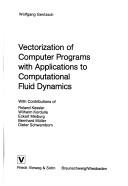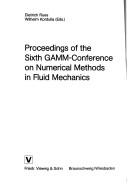| Listing 1 - 6 of 6 |
Sort by
|
Book
Year: 1974 Publisher: Aachen [s.n.]
Abstract | Keywords | Export | Availability | Bookmark
 Loading...
Loading...Choose an application
- Reference Manager
- EndNote
- RefWorks (Direct export to RefWorks)

ISBN: 3528080825 3322878619 9783528080822 Year: 1984 Volume: 8 Publisher: Braunschweig : Vieweg,
Abstract | Keywords | Export | Availability | Bookmark
 Loading...
Loading...Choose an application
- Reference Manager
- EndNote
- RefWorks (Direct export to RefWorks)
Fluid dynamics --- Computer programs --- -Dynamics --- Fluid mechanics --- Computer programs. --- -Computer programs --- Fluides, Mécanique des --- Fluides, Mécanique des. --- Algorithmes --- Fluid mechanics. --- Fluides, Mécanique des --- Code source (informatique) --- Fluid dynamics - Computer programs
Book
ISBN: 3642413773 3642413781 Year: 2014 Publisher: Berlin, Heidelberg : Springer Berlin Heidelberg : Imprint: Springer,
Abstract | Keywords | Export | Availability | Bookmark
 Loading...
Loading...Choose an application
- Reference Manager
- EndNote
- RefWorks (Direct export to RefWorks)
Viscous flow is usually treated in the frame of boundary-layer theory and as a two-dimensional flow. At best, books on boundary layers provide the describing equations for three-dimensional boundary layers, and solutions only for certain special cases. This book presents the basic principles and theoretical foundations of three-dimensional attached viscous flows as they apply to aircraft of all kinds. Though the primary flight speed range is that of civil air transport vehicles, flows past other flying vehicles up to hypersonic speeds are also considered. Emphasis is put on general three-dimensional attached viscous flows and not on three-dimensional boundary layers, as this wider scope is necessary in view of the theoretical and practical problems that have to be overcome in practice. The specific topics covered include weak, strong, and global interaction; the locality principle; properties of three-dimensional viscous flows; thermal surface effects; characteristic properties; wall compatibility conditions; connections between inviscid and viscous flows; flow topology; quasi-one- and two-dimensional flows; laminar-turbulent transition; and turbulence. Detailed discussions of examples illustrate these topics and the relevant phenomena encountered in three-dimensional viscous flows. The full governing equations, reference-temperature relations for qualitative considerations and estimations of flow properties, and coordinates for fuselages and wings are also provided. Sample problems with solutions allow readers to test their understanding. .
Viscous flow. --- Fluid dynamics. --- Engineering. --- Fluids. --- Thermodynamics. --- Heat engineering. --- Heat transfer. --- Mass transfer. --- Fluid mechanics. --- Aerospace engineering. --- Astronautics. --- Aerospace Technology and Astronautics. --- Engineering Fluid Dynamics. --- Fluid- and Aerodynamics. --- Engineering Thermodynamics, Heat and Mass Transfer. --- Dynamics --- Fluid mechanics --- Fluid dynamics --- Viscosity --- Hydraulic engineering. --- Construction --- Industrial arts --- Technology --- Space sciences --- Aeronautics --- Astrodynamics --- Space flight --- Space vehicles --- Engineering, Hydraulic --- Engineering --- Hydraulics --- Shore protection --- Hydromechanics --- Continuum mechanics --- Aeronautical engineering --- Astronautics --- Mass transport (Physics) --- Thermodynamics --- Transport theory --- Heat transfer --- Thermal transfer --- Transmission of heat --- Energy transfer --- Heat --- Mechanical engineering --- Chemistry, Physical and theoretical --- Mechanics --- Physics --- Heat-engines --- Quantum theory --- Hydrostatics --- Permeability
Digital
ISBN: 9783642413780 Year: 2014 Publisher: Berlin, Heidelberg Springer
Abstract | Keywords | Export | Availability | Bookmark
 Loading...
Loading...Choose an application
- Reference Manager
- EndNote
- RefWorks (Direct export to RefWorks)
Viscous flow is usually treated in the frame of boundary-layer theory and as a two-dimensional flow. At best, books on boundary layers provide the describing equations for three-dimensional boundary layers, and solutions only for certain special cases. This book presents the basic principles and theoretical foundations of three-dimensional attached viscous flows as they apply to aircraft of all kinds. Though the primary flight speed range is that of civil air transport vehicles, flows past other flying vehicles up to hypersonic speeds are also considered. Emphasis is put on general three-dimensional attached viscous flows and not on three-dimensional boundary layers, as this wider scope is necessary in view of the theoretical and practical problems that have to be overcome in practice. The specific topics covered include weak, strong, and global interaction; the locality principle; properties of three-dimensional viscous flows; thermal surface effects; characteristic properties; wall compatibility conditions; connections between inviscid and viscous flows; flow topology; quasi-one- and two-dimensional flows; laminar-turbulent transition; and turbulence. Detailed discussions of examples illustrate these topics and the relevant phenomena encountered in three-dimensional viscous flows. The full governing equations, reference-temperature relations for qualitative considerations and estimations of flow properties, and coordinates for fuselages and wings are also provided. Sample problems with solutions allow readers to test their understanding. .
Space research --- Astronomy --- Fluid mechanics --- Thermodynamics --- Mechanical properties of solids --- Hydraulic energy --- Applied physical engineering --- vloeistofstroming --- thermodynamica --- aerodynamica --- astronauten --- ingenieurswetenschappen --- ruimtevaart --- hydraulica --- vloeistoffen --- warmteoverdracht
Book
ISBN: 0444897933 9780444897930 Year: 1992 Publisher: Amsterdam : Elsevier,
Abstract | Keywords | Export | Availability | Bookmark
 Loading...
Loading...Choose an application
- Reference Manager
- EndNote
- RefWorks (Direct export to RefWorks)
Fluid dynamics --- Numerical analysis --- Analyse numérique --- Measurement --- Congresses --- Congrès --- 532.5 <063> --- 681.3*G18 <063> --- -Numerical analysis --- -Fluid dynamic measurements --- -51-74 --- 519.6 --- Measurements, Fluid dynamic --- Physical measurements --- Mathematical analysis --- Dynamics --- Fluid mechanics --- Liquid motion. Hydrodynamics--Congressen --- Partial differential equations: difference methods; elliptic equations; finite element methods; hyperbolic equations; method of lines; parabolic equations (Numerical analysis)--Congressen --- -Congresses --- Mathematics--?-74 --- Computational mathematics. Numerical analysis. Computer programming --- 519.6 Computational mathematics. Numerical analysis. Computer programming --- 51-74 Mathematics--?-74 --- 681.3*G18 <063> Partial differential equations: difference methods; elliptic equations; finite element methods; hyperbolic equations; method of lines; parabolic equations (Numerical analysis)--Congressen --- 532.5 <063> Liquid motion. Hydrodynamics--Congressen --- -Measurement

ISBN: 3528080876 9783528080877 Year: 1986 Volume: 13 Publisher: Braunschweig ; Wiesbaden : Vieweg,
Abstract | Keywords | Export | Availability | Bookmark
 Loading...
Loading...Choose an application
- Reference Manager
- EndNote
- RefWorks (Direct export to RefWorks)
| Listing 1 - 6 of 6 |
Sort by
|

 Search
Search Feedback
Feedback About UniCat
About UniCat  Help
Help News
News